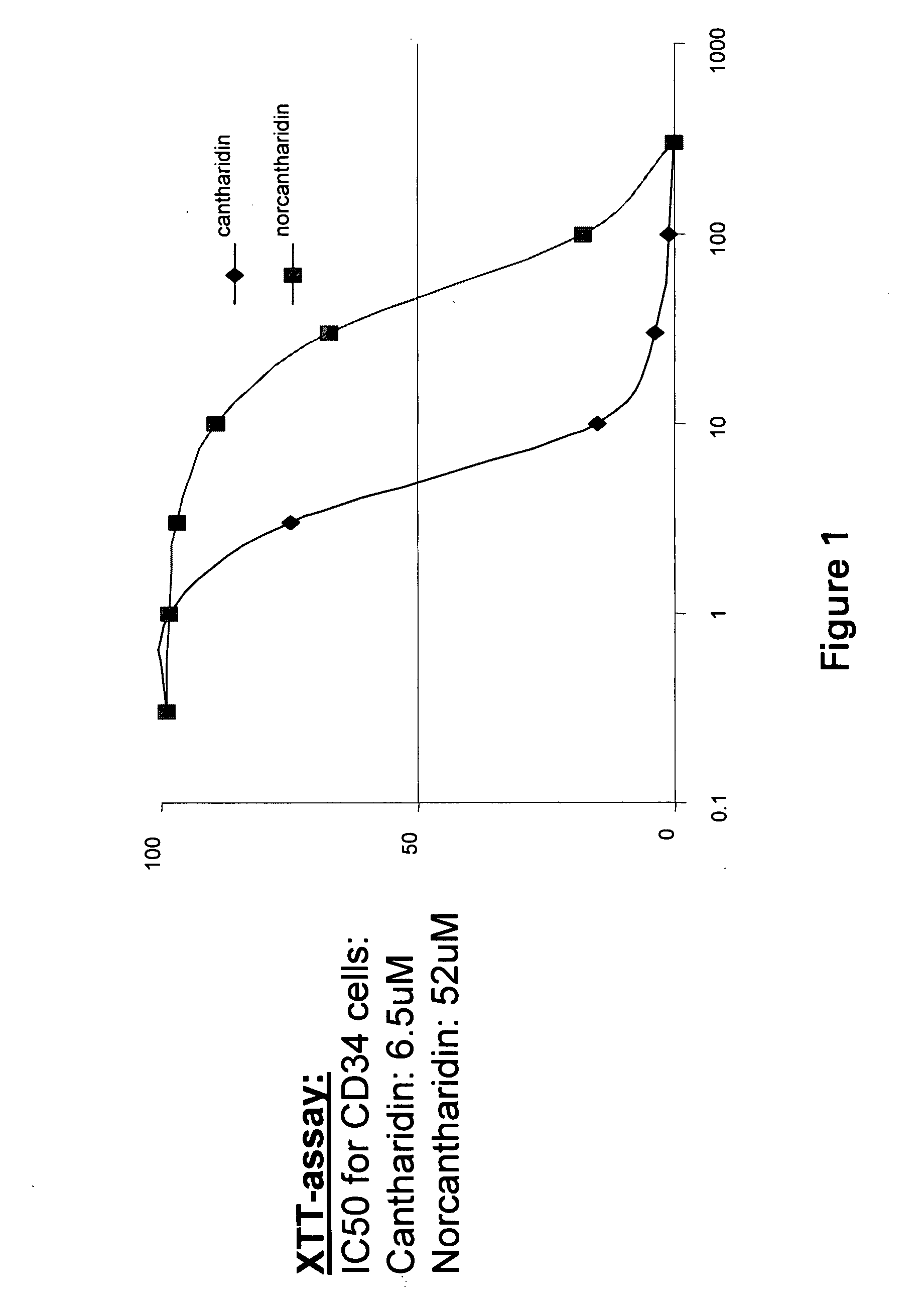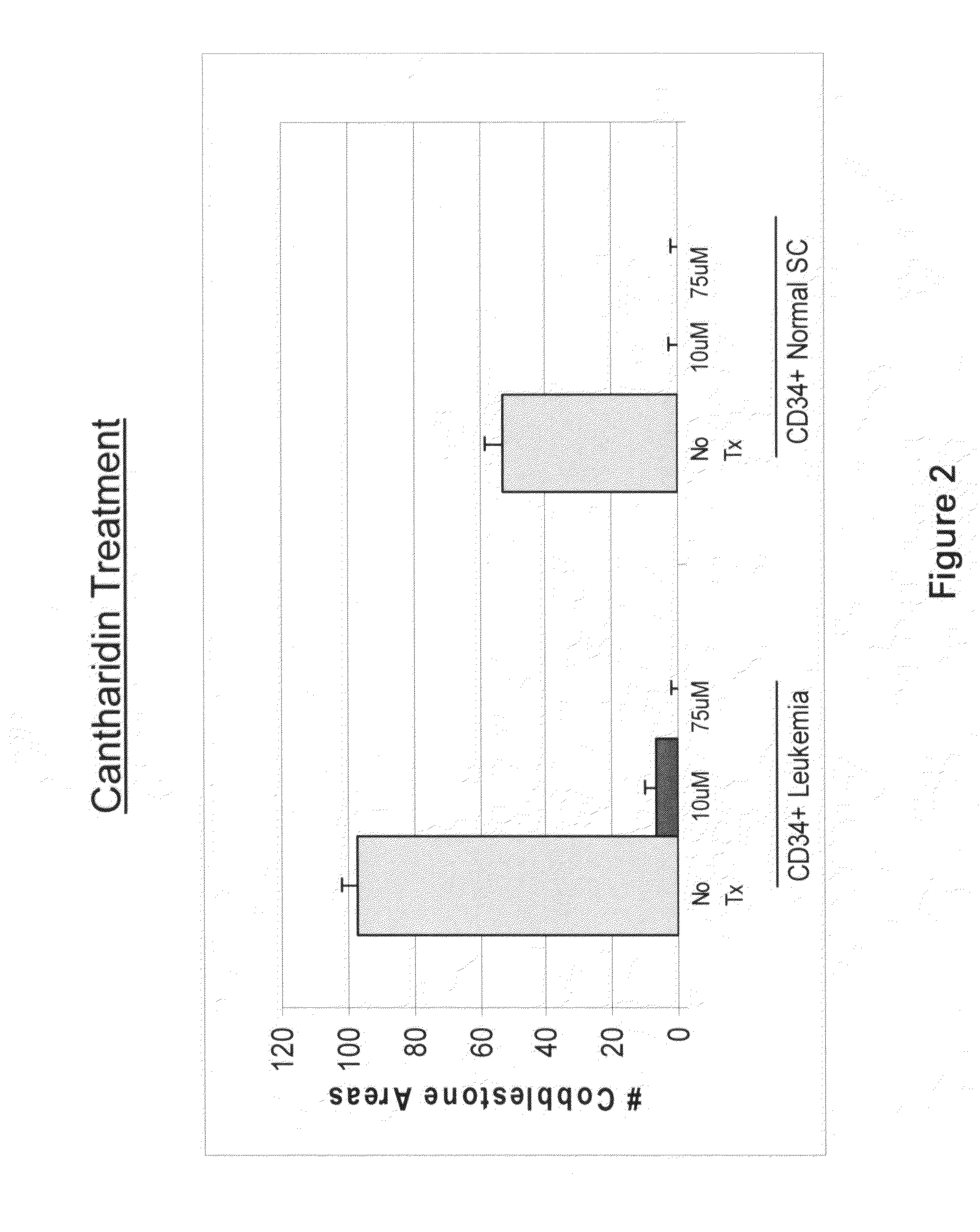Cancer therapy with cantharidin and cantharidin analogs
a cantharidin and cancer technology, applied in the field of cancer therapy with cantharidin and cantharidin analogs, can solve the problems of reducing the overall survival benefit of cancer cells, chemotherapy, radiation and other modalities including newer targeted therapies, and exerting toxic effects on cancer cells, so as to improve the efficacy of therapeutic modalities, avoid or reduce adverse or unwanted side effects, and reduce the effect of toxicity
- Summary
- Abstract
- Description
- Claims
- Application Information
AI Technical Summary
Benefits of technology
Problems solved by technology
Method used
Image
Examples
example 1
6.1 Example 1
Cytotoxicity of Cantharidin and Norcantharidin Against Leukemia Stem Cells
[0447]CD34+ cells were obtained from normal human cord blood by magnetic bead selection using anti-CD34 antibody coated beads. The cytotoxicity of cantharidin and norcantharidin against these cells was measured by a colorimetric assay using XTT (sodium 3′-{1-[(phenylamino)-carbonyl]-3,4-tetrazolium}-bis(4-methoxy-6-nitro) benzene-sulfonic acid hydrate). CD34+ cells were plated in 96-well plates and the following day, cells were exposed to varying doses of cantharidin and norcantharidin. 50 μL of 1 mg / mL XTT and 0.025 mM phenazine methosulfate (PMS) were added. The absorbance of the supernatant was measured at 450 and 630 nm of wells without drug (with cells) as 100% and wells without cells as 0%. FIG. 1 represents the dose response curve for CD34+ cells in the presence of cantharidin and norcantharidin. CD34+ cells were extremely sensitive to both compounds with an IC50 of 6.5 μM for cantharidin, ...
example 2
6.2 Example 2
Cobblestone Area Forming Cell Assay (CAFC) Comparing Cytotoxicity of Cantharidin and Norcantharidin Against Stem Cells from a Leukemic Patient and Stem Cells from Cord Blood (Normal Stem Cells)
[0448]Cells were treated with 10 μM and 75 μM cantharidin or norcantharidin overnight. To assay for stem cells by the cobblestone area forming cell (CAFC) assay, CD34+ cells subsequent to drug treatment were co-cultured with the MS-5 monolayer in X-Eagle minimum essential medium (α-MEM) containing 10% heat-inactivated FCS, 10% horse serum, 1×10−6 M hydrocortisone, 2 mM L-glutamine, and 100 U / mL penicillin / streptomycin. After 5 weeks in culture, total cobblestone areas were counted. FIGS. 2 and 3 show bar graphs representing cobblestone area counts in the presence of no drug (control) and 10 and 75 μM of cantharidin and norcantharidin, respectively, using CD34+ cells obtained from a leukemia patient, and CD34+normal stem cells isolated from human cord blood. The control sample show...
example 3
6.3 Example 3
Cytotoxicity of Cantharidin and Norcantharidin Against Cancer Cells (MV4; 11 Leukemic Cells)
[0449]The cytotoxicity of Cantharidin and Norcantharidin against MV4; 11 leukemia cells was measured by a calorimetric assay using XTT. MV4; 11 cells were plated in 96-well plates and the following day, cells were exposed to varying doses of cantharidin and norcantharidin. After 5 days of exposure to drugs, 50 μL of 1 mg / mL XTT and 0.025 mM phenazine methosulfate (PMS) were added. The absorbance of the supernatant was measured at 450 and 630 nm of wells not treated with drug (with cells) as 100% and wells without cells as 0%. MV4; 11 cells were extremely sensitive to both compounds with IC50 of 7.5 μM for cantharidin and 24 μM for norcantharidin.
PUM
| Property | Measurement | Unit |
|---|---|---|
| time | aaaaa | aaaaa |
| time | aaaaa | aaaaa |
| time | aaaaa | aaaaa |
Abstract
Description
Claims
Application Information
 Login to View More
Login to View More - R&D
- Intellectual Property
- Life Sciences
- Materials
- Tech Scout
- Unparalleled Data Quality
- Higher Quality Content
- 60% Fewer Hallucinations
Browse by: Latest US Patents, China's latest patents, Technical Efficacy Thesaurus, Application Domain, Technology Topic, Popular Technical Reports.
© 2025 PatSnap. All rights reserved.Legal|Privacy policy|Modern Slavery Act Transparency Statement|Sitemap|About US| Contact US: help@patsnap.com



